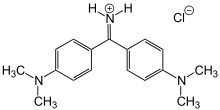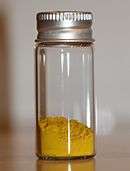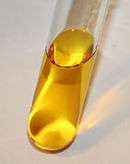Auramine O
 | |||
| |||
| Names | |||
|---|---|---|---|
| IUPAC name
bis[4-(dimethylamino)phenyl]methaniminium chloride | |||
| Other names
auramine hydrochloride, basic yellow 2, pyocatanium aureum, aizen auramine, pyoktanin yellow, canary yellow, pyoktanin, or C.I. 41000 | |||
| Identifiers | |||
3D model (JSmol) |
|||
| ChemSpider | |||
| ECHA InfoCard | 100.017.789 | ||
PubChem CID |
|||
| |||
| |||
| Properties | |||
| C17H22ClN3 | |||
| Molar mass | 303.83 g·mol−1 | ||
| Melting point | 267 °C (513 °F; 540 K) | ||
| Hazards | |||
| R-phrases (outdated) | R22 R24 R40 | ||
| S-phrases (outdated) | S36/37 S45 | ||
Except where otherwise noted, data are given for materials in their standard state (at 25 °C [77 °F], 100 kPa). | |||
| Infobox references | |||
Auramine O is a diarylmethane dye used as a fluorescent stain. In its pure form, Auramine O appears as yellow needle crystals. It is very soluble in water and soluble in ethanol.
Auramine O can be used to stain acid-fast bacteria (e.g. Mycobacterium, where it binds to the mycolic acid in its cell wall) in a way similar to Ziehl-Neelsen stain.[1] It can also be used as a fluorescent version of Schiff reagent.[2]
Auramine O can be used together with Rhodamine B as the Truant auramine-rhodamine stain for Mycobacterium tuberculosis.[3][4] It can be also used as an antiseptic agent.
References
- ↑ Kommareddi S, Abramowsky C, Swinehart G, Hrabak L (1984). "Nontuberculous mycobacterial infections: comparison of the fluorescent auramine-O and Ziehl-Neelsen techniques in tissue diagnosis". Hum Pathol. 15 (11): 1085–9. doi:10.1016/S0046-8177(84)80253-1. PMID 6208117.
- ↑ Khavkin T, Kudryavtseva M, Dragunskaya E, Polotsky Y, Kudryavtsev B (1980). "Fluorescent PAS-reaction study of the epithelium of normal rabbit ileum and after challenge with enterotoxigenic Escherichia coli". Gastroenterology. 78 (4): 782–90. PMID 6986320.
- ↑ Truant J, Brett W, Thomas W (1962). "Fluorescence microscopy of tubercle bacilli stained with auramine and rhodamine". Henry Ford Hosp Med Bull. 10: 287–96. PMID 13922644.
- ↑ Arrowood M, Sterling C (1989). "Comparison of conventional staining methods and monoclonal antibody-based methods for Cryptosporidium oocyst detection". J Clin Microbiol. 27 (7): 1490–5. PMC 267601. PMID 2475523.
External links
This article is issued from
Wikipedia.
The text is licensed under Creative Commons - Attribution - Sharealike.
Additional terms may apply for the media files.

